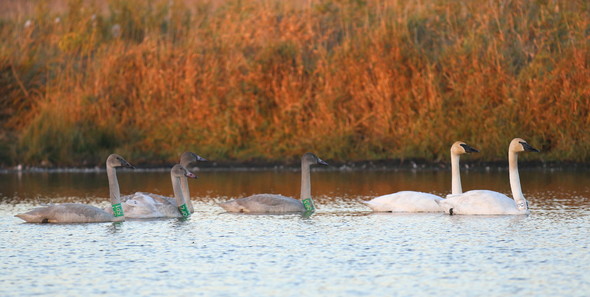|
October 23, 2020
As the Avian Ecologist for the Iowa DNR, I get the privilege and challenge of working with and conserving all of the nongame bird species in the state. But this past August and September I spent a lot of my time thinking about just one species, the Trumpeter Swan. My colleagues and I spent hours looking for swans, trying to think like swans, catching swans, and I even had a few dreams about swans. All of this focused attention was in the name of science and research!
A male Iowa Trumpeter Swan with a GPS collar swimming with his mate.
Iowa’s Trumpeter Swans are part of the larger Interior Population, with a breeding range from western Minnesota east to Michigan and Ohio, and from southern Iowa north to Manitoba and Ontario. This now healthy population was once extinct and is the result of state agency restoration efforts which started in the 1980s and 90s. Interest in learning more about the movement and habitat use of swans in the Interior Population led to a collaborative research project across 6 states and provinces. Led by the Minnesota Cooperative Fish and Wildlife Research Unit, biologists deployed GPS transmitters on Trumpeter Swans throughout the Interior Population in 2019 and 2020 to track their movement. These GPS collars are solar powered and record accurate locations every 15 minutes. They connect with cell phone towers to upload data directly to researchers twice each day and can record data for up to 3 years.
Check out this link to learn more about this project and for an up-to-date map of all the swans in the study:
 |
In Iowa, we were also interested in learning more about Trumpeter Swan young, or cygnets as they’re called for their first year of life. Unlike most other Iowa birds, cygnets stay with their parents for their whole first year of life; learning how to feed and survive the winter. Once the parents return to their wetlands to breed the following spring, they chase off their youngsters and the process starts all over. This life-history strategy gave us a unique opportunity to learn more about the cygnets of adults which received GPS collars. We marked each cygnet with a green neck collar and matching leg band with a unique 3-digit ID. Because the cygnets move with their GPS collared parent, it is possible to track the survival of each individual cygnet by periodically observing the somewhat-known location of the GPS-marked adult. By following the family over the first winter, we will learn more about survival rates, potential threats to survival, and habitat use, and next spring, we will learn more about where these youngsters go once their parents kick them out.
 |
Family Group of Swans
After 4 weeks of field work in late summer 2020 we captured and marked 51 trumpeter swans from 12 family groups. Nine adults were fitted with GPS collars and 40 cygnets were marked with green ID collars and leg bands. Two cygnets also received gray GPS collars and are part of a parallel ongoing Iowa State project.
GPS collar on adult bird and numbered green neck band put on cygnets
Although we captured the swans when they were unable to fly, by now all of the adults have completed their molt and all of the cygnets have fledged. This means the family groups are starting to move around more and their GPS tracks reveal new locations every day. We are excited to continue to follow the swans and their cygnets over the coming winter, but we need your help! If you come across an adult or cygnet with a collar, please make note of the time and date, the location, and the ID and color or all collars. Then fill in the online form so we can include your sighting in our research!
-Anna Buckardt Thomas, DNR Avian Ecologist
DNR staff after a successful capture! From left to right: Jenny Frederickson, Anna Buckardt, Rachel Ruden, Dave Hoffman, Professor Paul Skrade, and Tyler Harms.
|